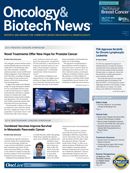Publication
Article
Oncology & Biotech News
ASH Meeting Highlights a Great Year and Builds Momentum Toward a New Era in Cancer Care
A few weeks ago, physicians and scientists from around the globe gathered in San Francisco for the 2014 American Society of Hematology (ASH) Annual Meeting. Let's review some trends, since there were key develÂopments across the board.
Andre Goy, MD
A few weeks ago, physicians and scientists from around the globe gathered in San Francisco for the 2014 American Society of Hematology (ASH) Annual Meeting. While it is well beyond the scope of this column to examine all of the significant data presented at ASH, let’s review some trends, since there were key devel­opments across the board.
The most striking results presented were those involving immune-based therapies, particularly with the definite en­trance of PD-1 inhibitors into hematology (ie, unleashing the immune system by blocking PD-1 T-cell induced exhaustion). Two PD-1 inhibitors showed dramatic activity in heavily pre­treated Hodgkin lymphoma: pembrolizumab (objective re­sponse rate [ORR] = 67%) and nivolumab (ORR = 87%).
Other immune-based therapies were also very impres­sive, with confirmation of the activity of bispecific antibod­ies (linking CD3 and CD19), such as blinatumomab, in acute lymphocyctic leukemia (ALL), and CAR T-cells showing du­rable complete remissions in 92% of pediatric patients with relapsed/refractory ALL.
The second obvious trend at ASH involved small mol­ecules, particularly BCR-targeted agents (ibrutinib, idelal­isib, duvelisib), with more mature data confirming activity in high-risk patients, such as those carrying a del17p, who typically have very poor outcomes with standard chemo­therapy. In a study of 140 patients with relapsed/refractory chronic lymphocytic leukemia (CLL) with del 17p, the ORR with ibrutinib was >80% and at 12 months, 79% of patients had not progressed, which is completely unexpected in that population.
Another development reported with small molecules in­volved the BCL2 inhibitor ABT-199 (venetoclax), with data confirming impressive activity across the board in B-cell malignancies. Also, for the first time, a benefit was shown with an IDH2 inhibitor (AG-221) in acute myeloid leukemia.
In another area, a number of new monoclonal antibodies are currently being tested in B-cell non-Hodgkin lymphoma (NHL), particularly naked anti-CD20 (obinutuzumab, ubli­tuximab, and ofatumumab, among others) or antibody-drug conjugates. For example, brentuximab vedotin significantly reduced the risk of relapse and extended progression-free survival (PFS) following autologous stem cell transplant for re­lapsed/refractory Hodgkin lymphoma (AETHERA trial). Bren­tuximab was also used as salvage therapy pre-transplant, ei­ther as a single agent or in combination (with bendamustine, particularly), and showed very impressive results, including a high complete remission rate. This will definitely change the landscape of Hodgkin lymphoma, including emerging data supporting replacement of chemotherapy in elderly patients in the frontline setting.
The momentum seen toward combinations of biological agents continues to expand in multiple myeloma (MM), typi­cally including the proteasome inhibitor bortezomib (and now carfilzomib, or ixazomib [an oral compound]), lenalido­mide (and now also pomalidomide) plus dexamethasone, providing unprecedented responses in the frontline setting.
The true breakthrough in MM, however, is likely the emergence for the first time of Mab candidates in myeloma, particularly those targeting CD38, such as elotuzumab or daratumumab, which have shown activity as single agents in relapsed/refractory MM, offering an option beyond the triplets backbone therapies (as we did with chemoimmu­notherapy in lymphoma).
Beyond this brief highlight of some specific developments from the meeting, a number of themes emerged from ASH that reflect the ongoing changes occurring in oncology.
1. Logically, combinations of small molecules are being ex­plored to replace chemotherapy with already promising results, including in high-risk patients with CLL, MCL, and indolent NHL.
2. Though such regimens appear to be potentially less toxic than standard cytotoxic chemotherapy (to some degree debatable), they are associated with extreme costs, par­ticularly for new regimens given for prolonged periods. On the other hand—for example—6 cycles of chemoim­munotherapy can definitely either cure or give very long remissions to subsets of patients with B-cell lymphomas. This issue is definitely—and should be—part of an honest debate moving forward with the development of novel strategies for cancer patients.
3. ASH joined the Choosing Wisely effort, which encourages physicians and patients to discuss the necessity of com­mon medical tests and treatments (eg, there is no need for extensive coagulopathy workup in patients who have a deep vein thrombosis or pulmonary embolism in the setting of a transient major risk factor). Without any doubt, this list will continue to grow as we engage physi­cians more toward cost/quality awareness.
4. Though there is an obvious growing presence of molecu­lar diagnostics in hematologic malignancies, there is still a huge gap with the clinic. Additional efforts are needed for a better molecular stratification of patients including on clinical trials, keeping in mind the need to streamline the exhaustive and lengthy process required through eli­gibility evaluation for such trials.
5. Finally, several trials continued to highlight the benefit of maintenance approaches (rituximab) in a number of B-cell malignancies. Though there is no doubt that PFS is extended, so far there is no clear benefit in overall surviv­al. In the current era of rationale, clinical benefit—based medi­cine, I believe we should move toward minimal residual disease (MRD)—based endpoints, including for mainte­nance decisions, as I previously detailed in this column.
Overall, ASH confirmed the extraordinary changes hap­pening in the field of hematological malignancies. Though rapidly changing times are often accompanied by some degree of confusion, with hundreds of new options on the horizon, it is a really good problem to have, and a great way to start the New Year.
Happy New Year to all!





















%20(2)%201-Recovered-Recovered-Recovered-Recovered-Recovered-Recovered-Recovered-Recovered-Recovered-Recovered-Recovered-Recovered-Recovered-Recovered-Recovered-Recovered-Recovered.jpg?fit=crop&auto=format)
%20(2)%201-Recovered-Recovered-Recovered-Recovered-Recovered-Recovered-Recovered-Recovered-Recovered-Recovered-Recovered-Recovered-Recovered-Recovered-Recovered-Recovered-Recovered.jpg?fit=crop&auto=format)